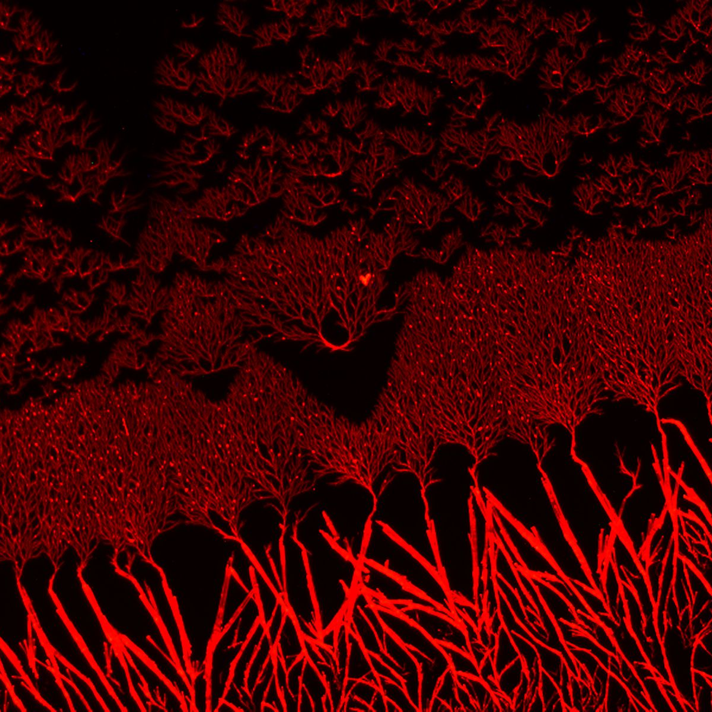
L'éclatement de Marangoni comme nouvelle méthode de synthèse de cristaux organiques
The Marangoni Bursting Effect as a Novel Synthesis Method of Organic Crystals
Michalina Slemp et Pierre-François Brevet (équipe ATMOS), en collaboration avec des collègues de Wroclaw ont publié un article intitulé "Tale of a Growth: Marangoni Bursting Phenomenon as a Viable Route for Obtaining Fibers of Organic Chromophores" dans la revue Journal of Physical Chemistry C. Cet article a fait la couverture de la revue.
Michalina Slemp and Pierre-Francois Brevet (team ATMOS), with colleagues from Wroclaw published an article entitled "Tale of a Growth: Marangoni Bursting Phenomenon as a Viable Route for Obtaining Fibers of Organic Chromophores" in the Journal of Physical Chemistry C. This article made the cover of the issue.
Imaginez. Vous terminez vos expériences, il est tard et il reste de la verrerie de laboratoire à laver. Vous êtes épuisé alors vous reportez cette tâche au lendemain. Par curiosité, le lendemain, vous passez la lame au microscope et sous vos yeux une myriade de structures rouges apparait, des petits cristaux à peine visible par fluorimétrie jusqu'à de gros fils atteignant plusieurs mm de longueur. Au cours de l’année suivante, vous découvrez peu à peu que vous avez mis en place une nouvelle méthode de synthèse de cristaux organiques.
Si une goutte d'alcool et d'eau dans un rapport approprié est placée sur la surface liquide ou solide bien lisse, l’effet appelé éclatement de Marangoni se produit, c’est-à-dire la séparation spontanée de la goutte en un grand nombre de gouttelettes en raison de la différence des vitesses d'évaporation. Si l'on ajoute un composé organique soluble dans l'alcool mais insoluble dans l'eau, alors le processus conduit à la formation de cristaux de différentes tailles.
Dans ce travail, le composé organique DCNP qui possède une forte réponse optique non linéaire quadratique a été utilisé. L’éclatement de Marangoni a alors permis d’obtenir à la fois des agrégats J et des agrégats H, dont l'existence a été prédite théoriquement il y a plus de 11 ans mais qui n’avaient jamais été observés auparavant ! Dans cet article, le potentiel de cette méthode de fabrication de cristaux organiques à large distribution de taille, de plusieurs nm à plusieurs mm de longueur, est présenté.
Si une goutte d'alcool et d'eau dans un rapport approprié est placée sur la surface liquide ou solide bien lisse, l’effet appelé éclatement de Marangoni se produit, c’est-à-dire la séparation spontanée de la goutte en un grand nombre de gouttelettes en raison de la différence des vitesses d'évaporation. Si l'on ajoute un composé organique soluble dans l'alcool mais insoluble dans l'eau, alors le processus conduit à la formation de cristaux de différentes tailles.
Dans ce travail, le composé organique DCNP qui possède une forte réponse optique non linéaire quadratique a été utilisé. L’éclatement de Marangoni a alors permis d’obtenir à la fois des agrégats J et des agrégats H, dont l'existence a été prédite théoriquement il y a plus de 11 ans mais qui n’avaient jamais été observés auparavant ! Dans cet article, le potentiel de cette méthode de fabrication de cristaux organiques à large distribution de taille, de plusieurs nm à plusieurs mm de longueur, est présenté.
Imagine. You have just finished your experiments, it is late and you still have some laboratory glassware to wash. You are exhausted so you decide to postpone the task until the next day. The next day, out of curiosity, you put the slide under a microscope and there you see a myriad of red structures, from small crystals barely detected by fluorimetry to large threads reaching several mm. Over the next year, you discover that what you have achieved is a new method for the growth of nonlinear optical organic dye crystals.
If a drop of alcohol and water in a proper ratio is dropped onto a smooth surface like an organic liquid or solid surface Marangoni bursting occurs, namely the spontaneous dispersion of the drop into smaller droplets due to difference in evaporation velocities of alcohol and water. Furthermore, adding an organic dye soluble in alcohol but insoluble in water then yields a forest of crystals of a large range of different size.
In the present work, polar DCNP, an organic dye with a strong quadratic nonlinear optical response, is used. Marangoni bursting yields both J aggregates as well as H aggregates, the existence of the latters having been predicted theoretically about 11 years ago but never observed yet. In this paper, the potential of this synthesis method for organic crystals ranging in size from several nm up to several mm in length is emphasized.
If a drop of alcohol and water in a proper ratio is dropped onto a smooth surface like an organic liquid or solid surface Marangoni bursting occurs, namely the spontaneous dispersion of the drop into smaller droplets due to difference in evaporation velocities of alcohol and water. Furthermore, adding an organic dye soluble in alcohol but insoluble in water then yields a forest of crystals of a large range of different size.
In the present work, polar DCNP, an organic dye with a strong quadratic nonlinear optical response, is used. Marangoni bursting yields both J aggregates as well as H aggregates, the existence of the latters having been predicted theoretically about 11 years ago but never observed yet. In this paper, the potential of this synthesis method for organic crystals ranging in size from several nm up to several mm in length is emphasized.


















